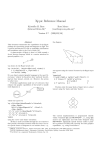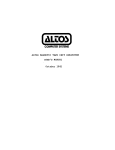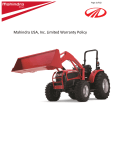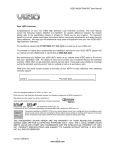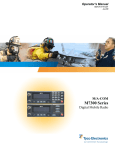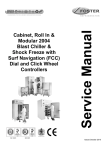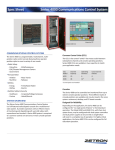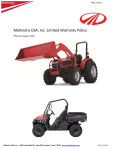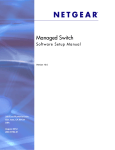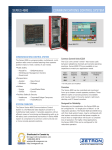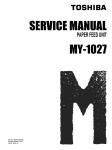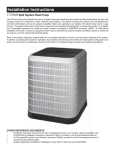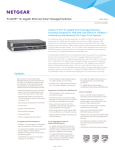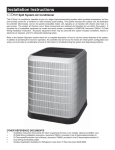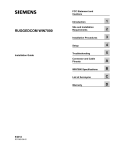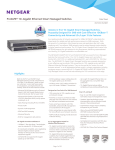Download MBC-100 Mobile Broadband Client Product Manual
Transcript
Product Manual 14221-6200-6010 Mar/12 Harris® LTE MBC-100 Mobile Broadband Client 14221-6200-6010 MANUAL REVISION HISTORY REV DATE - Mar/12 REASON FOR CHANGE Initial Release. Harris Corporation, Public Safety and Professional Communications (PSPC) Business continually evaluates its technical publications for completeness, technical accuracy, and organization. You can assist in this process by submitting your comments and suggestions to the following: Harris Corporation PSPC Business Technical Publications 221 Jefferson Ridge Parkway Lynchburg, VA 24501 fax your comments to: 1-434-455-6851 or e-mail us at: [email protected] ACKNOWLEDGEMENT This device is made under license under one or more of the following US patents: 4,590,473; 4,636,791; 5,148,482; 5,185,796; 5,271,017; 5,377,229; 4,716,407; 4,972,460; 5,502,767; 5,146,497; 5,164,986; 5,185,795; 5,226,084; 5,247,579; ; 5,491,772; 5,517,511; 5,630,011; 5,649,050; 5,701,390; 5,715,365; 5,754,974; 5,826,222; 5,870,405; 6,161,089; and 6,199,037 B1. DVSI claims certain rights, including patent rights under aforementioned U.S. patents, and under other U.S. and foreign patents and patents pending. Any use of this software or technology requires a separate written license from DVSI. CREDITS Harris, assuredcommunications, VIDA, EDACS and OpenSky are registered trademarks and NetworkFirst is a trademark of Harris Corporation. Conxall and Multi-Con-X are registered trademarks of Conxall Inc. Band-it is a registered trademark of BAND-IT-IDEX, Inc. A Unit of IDEX Corporation All other brand and product names are trademarks, registered trademarks, or service marks of their respective owners. NOTICE! The material contained herein is subject to U.S. export approval. No export or re-export is permitted without written approval from the U.S. Government. Rated: EAR99; in accordance with U.S. Dept. of Commerce regulations 15CFR774, Export Administration Regulations. Information and descriptions contained herein are the property of Harris Corporation. Such information and descriptions may not be copied or reproduced by any means, or disseminated or distributed without the express prior written permission of Harris Corporation, PSPC Business, 221 Jefferson Ridge Parkway, Lynchburg, VA 24501. Repairs to this equipment should be made only by an authorized service technician or facility designated by the supplier. Any repairs, alterations or substitutions of recommended parts made by the user to this equipment not approved by the manufacturer could void the user's authority to operate the equipment in addition to the manufacturer's warranty. This product conforms to the European Union WEEE Directive 2002/96/EC. Do not dispose of this product in a public landfill. Take it to a recycling center at the end of its life. This manual is published by Harris Corporation without any warranty. Improvements and changes to this manual necessitated by typographical errors, inaccuracies of current information, or improvements to programs and/or equipment, may be made by Harris Corporation at any time and without notice. Such changes will be incorporated into new editions of this manual. No part of this manual may be reproduced or transmitted in any form or by any means, electronic or mechanical, including photocopying and recording, for any purpose, without the express written permission of Harris Corporation. Copyright © 2012, Harris Corporation. All rights reserved. 2 14221-6200-6010 SOFTWARE LICENSE AGREEMENT THE SOFTWARE PROGRAM PROVIDED WITH THIS DOCUMENT IS FURNISHED UNDER A LICENSE AND MAY BE USED ONLY IN ACCORDANCE WITH THE FOLLOWING LICENSE TERMS. Harris Corporation RF Communications Division, hereafter referred to as COMPANY, grants to you, hereafter referred to as USER, a non-exclusive, paid up license to use the accompanying Software, the media on which it is recorded, and Programming Guide, all hereafter referred to as PRODUCT, for use under the following terms and conditions: 1. The techniques, algorithms, and processes contained in the PRODUCT constitute trade secrets of COMPANY. USER agrees not to provide or otherwise make available any PRODUCT to any third party and to take all measures reasonable and necessary to protect the confidentiality of the PRODUCT and COMPANY's rights herein. The foregoing shall not apply to any PRODUCT which USER can show was in its possession prior to the disclosure made by COMPANY, or which subsequently came into its possession through channels independent of COMPANY, or was independently developed by employees of USER who had not had access to PRODUCTS, or which appears in a printed publication other than as a breach of any obligation owed to COMPANY, or with the prior written permission of COMPANY. 2. USER shall not reproduce or copy the PRODUCT, make or permit any change or modification, in whole or in part, in its original or any other language, or permit anyone else to do so for any purpose whatsoever, except as necessary for the USER: a. This PRODUCT is for use on the single computer for which it is licensed here under. b. Except for Key Loader – to use it within the organization on multiple computers for which it is licensed here under. 3. USER shall not transfer the PRODUCT or any part thereof. This license does not include the right to sublicense and may not be assigned. 4. The PRODUCT is copyrighted under United States and International laws by COMPANY. USER agrees not to remove any COMPANY copyright, trademark or other notices or PRODUCT identification. 5. If USER does not comply with all of the terms and conditions of this license agreement, COMPANY may terminate this license and require USER to return the PRODUCT. USER's liability shall include, but not be restricted to, all costs incurred by COMPANY in recovering the PRODUCT and all damages arising from USER's default. 6. USER shall be solely responsible for determining the appropriate use to be made of the PRODUCT in USER's own operations. PRODUCTS ARE DISTRIBUTED "AS IS" WITHOUT WARRANTY OF ANY KIND, EITHER EXPRESSED OR IMPLIED. 7. USER is responsible to insure that use of the PRODUCT to install or repair COMPANY equipment meets all standards and regulations required by federal, state and local governments and that the operator of that mobile radio communications equipment is legally licensed for the use of the frequencies programmed into the radio equipment. 8. In no event, whether on warranty, contract or negligence, shall COMPANY be liable for special, incidental, indirect or consequential damages including, but not limited to, loss of profits or revenue, loss of use of any equipment, cost of capital, or any other loss that may result directly or indirectly from use of PRODUCTS or from failure of PRODUCTS to operate as intended. 9. The COMPANY cannot support software unless the specifications on the machine comply with COMPANY requirements in the COMPANY Software Release Notes. ECR-7378B 3 14221-6200-6010 TABLE OF CONTENTS Page 1 2 3 4 5 6 7 8 4 REGULATORY AND SAFETY INFORMATION .................................................................... 6 1.1 REGULATORY APPROVALS ............................................................................................ 6 1.1.1 Transmitter ............................................................................................................... 6 1.1.2 Receiver .................................................................................................................... 6 1.1.3 FCC Compliance ...................................................................................................... 6 1.1.4 Industry Canada ........................................................................................................ 6 1.2 SAFETY SYMBOL CONVENTIONS ................................................................................. 7 1.3 RF ENERGY EXPOSURE INFORMATION ....................................................................... 8 1.3.1 Safety Training Information ..................................................................................... 8 1.3.2 Contact Information.................................................................................................. 9 1.3.3 Occupational Safety Guidelines and Safety Training Information........................... 9 SPECIFICATIONS...................................................................................................................... 10 2.1 GENERAL .............................................................................................................................. 10 2.2 TRANSMITTER ...................................................................................................................... 10 2.3 RECEIVER ............................................................................................................................. 10 2.4 CONNECTION INTERFACES ................................................................................................... 11 2.5 LTE ...................................................................................................................................... 11 2.6 REGULATORY AND ENVIRONMENTAL .................................................................................. 11 INTRODUCTION........................................................................................................................ 12 3.1 EASY INSTALLATION AND CONFIGURATION ........................................................................ 12 3.2 ADVANCED DESIGN .............................................................................................................. 12 3.3 SECURITY ............................................................................................................................. 12 3.4 RUGGED ENCLOSURE ........................................................................................................... 12 UNPACKING AND CHECKING EQUIPMENT..................................................................... 13 4.1 UNPACKING EQUIPMENT .............................................................................................. 13 4.2 INSPECTING AND INVENTORYING EQUIPMENT ..................................................... 13 4.3 ITEMS INCLUDED ............................................................................................................ 13 OPTIONS AND ACCESSORIES ............................................................................................... 14 PLANNING THE INSTALLATION ......................................................................................... 15 6.1 GENERAL .............................................................................................................................. 15 6.2 TOOLS................................................................................................................................... 16 ANTENNA INSTALLATION .................................................................................................... 17 7.1 ANTENNA MOUNTING LOCATIONS ............................................................................ 17 7.1.1 Direct Center or Center-Rear of Rooftop ............................................................... 17 7.1.2 Center of Trunk Lid ................................................................................................ 17 7.1.3 Rear Deck Lid (GPS Antenna) ............................................................................... 17 7.2 ANTENNA INSTALLATION PROCEDURES ................................................................. 19 7.2.1 Installing NMO Antenna Mounts AN-125001-001, -002, -003, and -004 ............. 19 7.2.2 Installing NMO Magnetic Antenna Mounts AN-125001-007 and AN-125001-008 ..................................................................................................... 21 7.2.3 Attaching NMO Antenna Elements ........................................................................ 22 7.2.4 Installing the Coax Cable and TNC RF Connector ................................................ 22 7.2.5 Install GPS Antenna ............................................................................................... 23 MBC-100 INSTALLATION ....................................................................................................... 25 8.1 LTE SIM CARD INSTALLATION ............................................................................................. 25 8.2 INSTALLATION LOCATION .................................................................................................... 26 8.3 MOUNTING BRACKET INSTALLATION ................................................................................. 26 8.4 DC POWER ............................................................................................................................ 27 14221-6200-6010 TABLE OF CONTENTS Page 8.4.1 8.4.2 General ................................................................................................................... 27 DC Power Cable Installation .................................................................................. 27 8.5 USB CONNECTION ................................................................................................................. 30 8.6 LED STATUS INDICATORS ............................................................................................ 31 9 COMPLETING THE INSTALLATION ................................................................................... 32 9.1 SOFTWARE INSTALLATION ................................................................................................... 32 9.1.1 Firmware Upgrade .................................................................................................. 32 9.2 INITIAL POWER-UP ............................................................................................................... 33 9.3 VERIFICATION TEST.............................................................................................................. 33 9.3.1 LTE ......................................................................................................................... 33 9.3.2 GPS ......................................................................................................................... 34 10 TROUBLESHOOTING AND SERVICING ............................................................................. 35 10.1 TROUBLESHOOTING ...................................................................................................... 35 10.2 SERVICING ........................................................................................................................ 35 11 CUSTOMER SERVICE .............................................................................................................. 36 11.1 TECHNICAL SUPPORT........................................................................................................... 36 11.2 CUSTOMER CARE ................................................................................................................. 36 WARRANTY ...................................................................................................................................... 37 LIST OF FIGURES Page Figure 6-1: MBC-100 Rear View ......................................................................................................... 16 Figure 7-1: Antenna Mounting Locations ............................................................................................ 18 Figure 7-2: Installing a Standard ¾-Inch NMO Antenna Mount (e.g., AN-125001-001 or AN-125001-002) ............................................................................................................. 21 Figure 7-3: Installing AN-125001-003 or AN-125001-004 ................................................................ 21 Figure 7-4: Crimping Instructions for TNC RF Connector ................................................................. 23 Figure 8-1: SIM Slot Cover .................................................................................................................. 25 Figure 8-2: Insert SIM Card ................................................................................................................. 25 Figure 8-3: SIM Card Installed............................................................................................................. 25 Figure 8-4: Mounting Bracket and Associated Hardware ................................................................... 26 Figure 8-5: Top Mounted Bracket ........................................................................................................ 26 Figure 8-6: Bottom Mounted Bracket .................................................................................................. 26 Figure 8-7: Pivot Hole .......................................................................................................................... 26 Figure 8-8: USB Cable (W95-0011-xxx) .............................................................................................. 27 Figure 8-9: DC Power Cable (14014-0205-A1) ................................................................................... 27 Figure 8-10: Wiring Diagram for DC Power Cable Installation .......................................................... 30 Figure 9-1: LTE Monitor Application – Advanced Tab....................................................................... 33 Figure 9-2: LTE Monitor Application – GPS Tab ............................................................................... 34 LIST OF TABLES Page Table 1-1: MPE Table ........................................................................................................................... 9 Table 5-1: MBC-100 Options and Accessories .................................................................................... 14 Table 8-1: LED Status Indicators ......................................................................................................... 31 5 14221-6200-6010 1 REGULATORY AND SAFETY INFORMATION 1.1 REGULATORY APPROVALS 1.1.1 Transmitter The MBC-100 contains a modular transmitter. The transmitting device contained within and listed below has been tested and meets the following regulatory requirements: MODEL DESCRIPTION FCC ID (PART 90) INDUSTRY CANADA (RSS-119) PBM-100 700MHz LTE B14 PEM Module BV8BBPBM100 3670A-BBPBM100 1.1.2 Receiver This receiver associated with this transmitting device has been tested and declared to meet the regulatory requirements defined in the following sub-sections. Associated FCC labelling may be found on page 2. 1.1.3 FCC Compliance This device complies with Part 15 of the FCC Rules. Operation is subject to the following conditions: 1. This device may not cause harmful interference, and 2. This device must accept any interference received, including interference that may cause undesired operation. 3. The user should take caution that changes or modifications not expressly approved by Harris could void the user’s authority to operate this equipment. All required software and operating conditions must not be violated by the installer/user and is an express condition of use for this equipment. 1.1.4 Industry Canada This device complies with Industry Canada licence-exempt RSS standard(s). Operation is subject to the following two conditions: (1) this device may not cause interference, and (2) this device must accept any interference, including interference that may cause undesired operation of the device. Le présent appareil est conforme aux CNR d'Industrie Canada applicables aux appareils radio exempts de licence. L'exploitation est autorisée aux deux conditions suivantes: (1) l'appareil ne doit pas produire de brouillage, et (2) l'utilisateur de l'appareil doit accepter tout brouillage radioélectrique subi, même si le brouillage est susceptible d'en compromettre le fonctionnement. WARNING 6 The installer of this MBC-100 must ensure that the antenna is located or pointed such that it does not emit RF field in excess of Health Canada limits for the general population; consult Safety Code 6, obtainable from Health Canada’s website www.hcsc.gc.ca/rpb. 14221-6200-6010 1.2 SAFETY SYMBOL CONVENTIONS The following conventions may be used in this manual to alert the user to general safety precautions that must be observed during all phases of operation, service, and repair of this product. Failure to comply with these precautions or with specific warnings elsewhere in this manual violates safety standards of design, manufacture, and intended use of the product. Harris Corporation assumes no liability for the customer's failure to comply with these standards. WARNING CAUTION The WARNING symbol calls attention to a procedure, practice, or the like, which, if not correctly performed or adhered to, could result in personal injury. Do not proceed beyond a WARNING symbol until the conditions identified are fully understood or met. The CAUTION symbol calls attention to an operating procedure, practice, or the like, which, if not performed correctly or adhered to, could result in a risk of danger, damage to the equipment, or severely degrade the equipment performance. The NOTE symbol calls attention to supplemental information, which may improve system performance or clarify a process or procedure. NOTE The ESD symbol calls attention to procedures, practices, or the like, which could expose equipment to the effects of Electro-Static Discharge. Proper precautions must be taken to prevent ESD when handling circuit modules. The electrical hazard symbol is a WARNING indicating there may be an electrical shock hazard present. This symbol indicates the presence of a potential RF hazard. 7 14221-6200-6010 1.3 RF ENERGY EXPOSURE INFORMATION To ensure that exposure to RF electromagnetic energy is within the FCC allowable limits for occupational use, always adhere to the following guidelines: CAUTION • DO NOT operate the MBC-100 without a proper antenna attached, as this may damage the MBC-100 and may also cause the FCC RF exposure limits to be exceeded. A proper antenna is the antenna supplied with this MBC-100 by Harris Corporation or an antenna specifically authorized by Harris for use with this MBC-100. • DO NOT operate the MBC-100 with a separation distance of less than 20 centimeters distance between radiating structures and the body of the user. At least 20 centimeters of separation between the antenna and the user’s body must be maintained at all times. 1.3.1 Safety Training Information YOUR HARRIS MBC-100 GENERATES RF ELECTRO-MAGNETIC ENERGY DURING TRANSMIT MODE. THIS MBC-100 IS DESIGNED FOR AND CLASSIFIED AS “OCCUPATIONAL USE ONLY,” MEANING IT MUST BE USED ONLY IN THE COURSE OF EMPLOYMENT BY INDIVIDUALS AWARE OF THE HAZARDOUS RF ENERGY AND THE WAYS TO MINIMIZE EXPOSURE. THIS STATION IS NOT INTENDED FOR USE BY THE “GENERAL POPULATION” IN AN UNCONTROLLED ENVIRONMENT. IT IS THE RESPONSIBILITY OF THE LICENSEE TO ENSURE THAT THE MAXIMUM PERMISSIBLE EXPOSURE LIMITS ARE OBSERVED AT ALL TIMES DURING TRANSMISSION. THE STATION LICENSEE IS TO ENSURE THAT NO BYSTANDERS COME WITHIN THE RADIUS OF THE LIMITS. When licensed by the FCC, this device complies with the FCC RF exposure limits when persons are beyond the MPE radius of the antenna (see Table 1-1). In addition, your Harris MBC-100 installation complies with the following Standards and Guidelines with regard to RF energy and electromagnetic energy levels and evaluation of such levels for exposure to humans: FCC OET Bulletin 65 Edition 97-01 Supplement C, Evaluating Compliance with FCC Guidelines for Human Exposure to RADIO Frequency Electromagnetic Fields. American National Standards Institute (C95.1 – 1992), IEEE Standard for Safety Levels with Respect to Human Exposure to RADIO Frequency Electromagnetic Fields, 3 kHz to 300 GHz. American National Standards Institute (C95.3 – 1992), IEEE Recommended Practice for the Measurement of Potentially Hazardous Electromagnetic Fields – RF and Microwave. 8 14221-6200-6010 Table 1-1: MPE Table Safe Distance, Rsafe, (cm) Controlled Uncontrolled Environment Environment Antenna Model # Antenna Part # Description BBAN6S E75-9146-001 Base Loaded 5/8 Wave >20 >20 BBAN6T AN-225001-002 Elevated Feed >20 >20 CAUTION To ensure that your exposure to RF electromagnetic energy is within the FCC allowable limits for occupational use, do not operate the station in a manner that would create an MPE distance less than that allowable by the FCC. Changes or modifications not expressly approved by Harris Corporation could void the user’s authority to operate the equipment. CAUTION 1.3.2 Contact Information For additional information on exposure requirements or other information, contact Harris Corporation at 1-800-528-7711 or at http://www.pspc.harris.com. 1.3.3 Occupational Safety Guidelines and Safety Training Information To ensure bodily exposure to RF electromagnetic energy is within the FCC allowable limits for occupational use. Always adhere to the following basic guidelines: 1. The MBC-100 should only be used for necessary work-related communications. 2. The MBC-100 should only be used by authorized and trained personnel. 3. Do not attempt any unauthorized modification to the MBC-100. Changes or modifications to the MBC-100 may cause harmful interference and/or cause it to exceed FCC RF exposure limits. Only qualified personnel should service the MBC-100. 4. Always use Harris authorized accessories (antennas, cables, etc.). Use of unauthorized accessories can cause the FCC RF exposure compliance requirements to be exceeded. The information listed above provides the user with information needed to make him or her aware of a RF exposure, and what to do to assure that this MBC-100 operates within the FCC exposure limits of this radio. 9 14221-6200-6010 2 SPECIFICATIONS 2.1 GENERAL 2.2 2.3 Dimensions (H x W x D): 3.90 × 6.25 × 1.50 in (99 × 158 × 38 mm) Weight: 1.25 lb (0.567 kg) DC Supply Voltage: USB or 12 VDC Mounting: Mounting Bracket Supplied Operating Temperature Range: -22 to +140°F (-30 to +60°C) Storage Temperature Range: -40 to +158°F (-40 to +70°C) Humidity: Maximum 95% Relative Humidity @ 122°F (+50°C) TRANSMITTER Frequency Range (MHz): 788 – 798 Channel Size (MHz): 5 or 10 Output Power (dBm): +23 Minimum Output Power (dBm): -40 Spectrum Emissions Mask: Per 3GPP TS 36.101 RECEIVER Frequency Range (MHz): 758 - 768 Channel Size (MHz): 5 or 10 MIMO: 1 TX, 2 RX Reference Sensitivity Power Level: 10 QPSK, 5 MHz BW (dBm): -97 QPSK, 10 MHz BW (dBm): -94 Maximum Input Level (dBm): -25 Maximum Tolerable Level (dBm): 0 No damage Adjacent Channel Selectivity (dB): 33 14221-6200-6010 2.4 CONNECTION INTERFACES Computer Interface: USB 2.0 High Speed (480 Mbit/s) Computer Connector: Standard Type B Plug Auxiliary Power Interface: 12 VDC Auxiliary Power Connector: 2.5 mm ID 5.5 mm OD Barrel Jack RF Interface: 2 port: one Tx/Rx port and one Rx port RF Connector: LTE = 50 ohm TNC Female GPS = 50 ohm SMA Female LED Indicators: 2.5 2.6 GPS DC bias supply 3.0V/40mA max Power status indicator LTE network status indicator Data connection indicator LTE Protocol: 3GPP Release 8 Uplink Access Methodology: DFT (SC-FDMA) Downlink Access Methodology: OFDMA Duplex Mode: FDD Uplink MCS: QPSK, 16QAM Downlink MCS: QPSK, 16QAM, 64QAM Downlink Throughput: 18 Mbps/5 MHz sector Uplink Throughput: 6 Mbps/5 MHz sector REGULATORY AND ENVIRONMENTAL FCC Certification: FCC Part 90, FCC Part 2, FCC Part 27 Emissions Designator: 5 MHz BW, QPSK: 4M52G7D 5 MHz BW, 16QAM: 4M52W7D RoHS Compliance: 2002/95/EC Environmental: MIL-STD-810G Ingress Protection: IP65 ESD Immunity: IEC 61000-4-2 11 14221-6200-6010 3 INTRODUCTION This manual provides installation and user information for the Harris LTE MBC-100 Mobile Broadband Client. The MBC-100 allows public safety subscribers on a private LTE network to obtain up to 18 Mbps of service for high bandwidth mobile applications. Using the MBC-100, first responders can access streaming video feeds, online databases, and mobile productivity applications in the field and when traveling to the scene of an incident. 3.1 EASY INSTALLATION AND CONFIGURATION The MBC-100 connects easily to existing vehicular computers using a single USB 2.0 connector for both power and data. Windows® drivers are supplied with the MBC, allowing existing data applications to establish network connectivity through the MBC. In cases where USB DC power is not sufficient, the optional external power connector can be used to provide 12 VDC power to the MBC-100. The only other installation requirement is the connection of external antennas used by the MBC-100 for the internal GPS receiver and LTE transceiver. To facilitate large deployments, the MBC-100 supports over-the-air provisioning and programming for simplified management of fielded devices. NOTE 3.2 When powered by USB, the GPS is disabled by default for power savings. When powered by 12 VDC, the GPS receiver is enabled and a COM port for GPS data is made available to the host. ADVANCED DESIGN With its industry-leading architecture, the MBC fully supports 3GPP Release 8 requirements today and is easily upgradable to Release 9. This means the MBC is capable of the advanced LTE modulations, 2x2 Multiple Input/Multiple Output (MIMO) support, Quality of Service, and Access Control features required to ensure public safety users can get priority broadband transmissions and guaranteed bandwidth for mission-critical support of high bandwidth applications. Using the MBC, first responders can receive streaming video feeds, access critical databases, and provide geo-location information simultaneously with multiple uplink/downlink bearer paths. To provide the best network coverage, the MBC uses external transmit and receive antennas. To support location-based services and situational awareness applications, the MBC-100 includes an internal GPS receiver with API-level access to the subscriber’s positional information. 3.3 SECURITY The MBC-100 supports the 3GPP TS-33 410 industry standard for mutual authentication and 128-bit encryption with over-the-air negotiation of traffic keys. This encryption provides robust security for public safety transmissions. 3.4 RUGGED ENCLOSURE The MBC-100 is built to public safety requirements with a mechanically hardened case rated for IP65 usage. The unit also passes MIL-STD-810G environmental qualification testing while maintaining RoHS compliance as a ‘green’ product. 12 14221-6200-6010 4 UNPACKING AND CHECKING EQUIPMENT Before unpacking, installing, or operating the MBC-100, read this section of the manual thoroughly. It contains detailed unpacking and handling instructions, and safety precautions to protect users and equipment. 4.1 UNPACKING EQUIPMENT When unpacking the equipment, check the contents against the packing list. representative and the carrier if any discrepancies are noted. Contact your Harris Save the shipping cartons and packing materials in case the equipment needs to be shipped back to the Harris for service. NOTE 4.2 INSPECTING AND INVENTORYING EQUIPMENT Carefully unpack the equipment and examine each item. If there is any damage to the equipment, contact the carrier immediately and have their representative verify the damage. If you fail to report the shipping damages immediately, you may forfeit any claim against the carrier. CAUTION 4.3 After removal from the carton, examine the MBC-100 for broken, damaged, loose, or missing parts. Examine the connectors for cracks, bent or damaged threads, or damage to any paint or seals. If any are noted, contact the Customer Care Center immediately. Any unauthorized attempts to repair or modify this equipment will void the warranty and could create a safety hazard. ITEMS INCLUDED MBC-100 Base Package (BBMBC100): The following items are included in the MBC-100 Base Package: • MBC-100 Assembly - 14014-1000-01 • Quick Guide - 14221-6200-1010 MBC-100 Installation Kit (BBZN9U): The following items are included in the MBC-100 Installation Kit: • Mounting Bracket - 14014-0106-01 • Four (4) #4-40 x 5/16" Phillips head screws with washers – H21-0001-005 • DC Power Cable - 14014-0205-A1 • In-line waterproof fuse holder - F01-0012-002 • 1 amp fuse - F-0008 • Non-insulated ¼” terminal lug ring, 22-16 AWG - E59-0003-006 • 2.5 mm barrel power plug – J62-0009-102 (SPARE) 13 14221-6200-6010 5 OPTIONS AND ACCESSORIES Table 5-1: MBC-100 Options and Accessories OPTION NUMBER BBZN9U PART NUMBER 14014-0106-01 Bracket, LTE Mobile Modem H21-0001-005 4 Phillips head screws with washers 14014-0205-A1 DC Power Cable F01-0012-002 F-0008 14 DESCRIPTION In-line waterproof fuse holder 1 amp fuse E59-0003-006 Non-insulated ¼” terminal lug ring, 22-16 AWG J62-0009-102 2.5 mm barrel power plug BBAN6S E75-9146-001 LTE Antenna, Short element, with base BBAN6T AN-225001-002 LTE Antenna, Elevated feed, 3db gain, black BBAN5F AN-025187-001 GPS Roof Mount Antenna BBAN3L AN-025187-003 GPS Magnet Mount Antenna BBAN6Q AN-125001-001 Standard Roof Mount BBAN6U AN-125001-002 Standard Roof Mount, Low Loss Antenna BBAN6V AN-125001-003 Thick Roof Mount Antenna BBAN6W AN-125001-004 Thick Roof Mount, Low Loss Antenna BBAN6R AN-125001-005 Standard Roof Mount with GPS Antenna BBAN6Z AN-125001-006 Standard Roof Mount with GPS, Low Loss Antenna BBAN6X AN-125001-007 Magnetic Roof Mount Antenna BBAN6Y AN-125001-008 Magnetic Roof Mount, Low Loss Antenna BBCA3X-01 W95-0011-601 USB cable, 1.0 m BBCA3X-02 W95-0011-602 USB cable, 2.0 m BBCA3X-03 W95-0011-603 USB cable, 3.0 m BBCA3X-05 W95-0011-605 USB cable, 5.0 m 14221-6200-6010 6 PLANNING THE INSTALLATION 6.1 GENERAL This section provides general information regarding installation of the MBC-100. For best results, the MBC should be installed by one of the many Harris Authorized Service Centers located throughout the United States. Their experienced service personnel can provide a proper installation and make any final adjustments that may be needed. Before starting the installation, plan carefully to ensure the installation meets the following requirements: • Safe for the operator and passengers • Away from airbag deployment area • Convenient for the operator to use • Neat, safe, and clean • Protected from water damage • Easy to service • Cable connections are accessible • Out of the way of auto mechanics • Out of the way of passengers WARNING Vehicular Electronics - Electronic fuel injection systems, electronic anti-skid braking systems, electronic cruise control systems, etc., are typical of the types of electronic devices which may be prone to malfunction due to the lack of protection from radio frequency energy present when a radio is transmitting. If the vehicle contains such equipment, consult the dealer to determine if such electronic equipment will perform normally when the radio is transmitting. WARNING Air Bags – For driver and passenger safety, avoid mounting the radio above or near airbag deployment areas. Note that vehicles may contain front driver and passenger side airbags as well as side airbags. For occupant safety, verify the location of all airbags before installing radio equipment. WARNING For passenger safety, mount the radio securely so that the unit will not break loose in the event of a collision. This is especially important in station wagons, vans, and similar type installations where a loose radio could be extremely dangerous to the vehicle occupants. When determining a mounting location for the MBC-100 and associated peripherals, avoid high traffic environments within the passenger compartment, trunk, or other compartment where feet, tools, or other objects may accidentally damage cable connections. The MBC-100 and other peripherals should be mounted such that connectors and other fragile components face away from high traffic areas, yet are accessible for servicing. 15 14221-6200-6010 Figure 6-1: MBC-100 Rear View 6.2 TOOLS The following tools are recommended to complete the installation. Where specific vendor names and model or part numbers are given, equivalent substitutes may be used: • Non-Insulated Crimp Tool: Thomas & Betts • Phillips-Head Screwdriver, #4 WT-111-M • Insulated Terminal Crimp Tool: Klein 1005 • 4-Millimeter Hex Key Wrench • • • • • Ratcheting Hex-Crimp Tool for 50-Ohm TNC and BNC RF Connectors and RG-58 Cable similar to Tyco Electronics 58433-2 (includes Crimper 354940-1 and Die Set 58436-1) or Emerson Network Power 24-9960P Non-Metallic Fish Tape, 25-Foot: Klein-Lite 50156 • ¾-Inch or ⅜-Inch Hole Saw with Depth Protection: ¾-Inch = Ripley HSK 19 or Antenex HS34; ⅜-Inch = Antenex HS38 • Clutch-Type Cordless Drill with Drill Bits and Driver Bits Deburring Tool (for ⅜-inch and smaller holes) Flush-Cut and Large Wire Cutters • • 16 ⅛-Inch Hex Key Wrench (Allen Wrench) /16-Inch Combination or Open-End Wrench (Only Needed for GPS Receiver Option) 3-Blade Coax Cable Stripper for RG-58 Cable similar to Tyco Electronics 1490490-1 (includes blades) 5 • Various Socket and Driver Sets • Various Fasteners (e.g., machine screws and nuts, Tek screws, etc.) • Soft-Jaw Pliers: Tessco 450520 or equivalent • Tie Wraps: Nylon, 6-inches or larger 14221-6200-6010 7 ANTENNA INSTALLATION 7.1 ANTENNA MOUNTING LOCATIONS WARNING At this time, review all information presented in Section 1. A transmitting antenna must be installed in accordance with the guidelines presented in Section 1 and in this section. Antennas must be mounted in one of four (4) possible locations on the vehicle. Figure 7-1 shows the recommended locations and antenna part numbers. Always follow the antenna manufacturer’s instructions when mounting an antenna. 7.1.1 Direct Center or Center-Rear of Rooftop The center of the vehicle’s roof is the best location for a rooftop-mount antenna (location in Figure 7-1). For optimal performance, the mounting area under the antenna must be flat with a minimum radius of six (6) inches of metal ground plane. It must be located directly in the center of the roof to minimize human exposure to RF electromagnetic energy. Other obstructions such as a light bar or another antenna may prevent the antenna from being mounted in the direct center of the roof. In this case, the antenna should be mounted a minimum of one foot away from and behind the obstruction but in the middle of the roof with respect to the left and right sides of the vehicle (location in Figure 7-1). 7.1.2 Center of Trunk Lid Certain vehicles do not allow for the antenna to be placed in the center or center-rear of the roof. In this case, the next best location for the antenna is in the direct center of the trunk lid (location in Figure 7-1). In this case, an elevated-feed-point antenna is recommended. Although this type of antenna does not require a metal ground plane, it must be located directly in the center of the trunk lid to minimize human exposure to RF electromagnetic energy. 7.1.3 Rear Deck Lid (GPS Antenna) A stand-alone GPS receive antenna must be separately located and mounted. The vehicle’s rear deck lid (location in Figure 7-1) is the recommended mounting location for this case. This locates the GPS antenna inside the vehicle. The GPS connection supports active antennas by providing DC bias to the center pin of the SMA connector. Only use approved GPS antennas. NOTE 17 14221-6200-6010 TOP VIEW OF A TYPICAL VEHICLE Rooftop Trunk Lid Hood ANTENNA MODEL NUMBER ANTENNA PART NUMBER BBAN6S E75-9146-001 LTE Antenna, Short element, with base BBAN6T AN-225001-002 LTE Antenna, Elevated feed, 3db gain, black BBAN5F AN-025187-001 GPS Roof Mount Antenna BBAN3L AN-025187-003 GPS Magnet Mount Antenna BBAN6Q AN-125001-001 Standard Roof Mount BBAN6U AN-125001-002 Standard Roof Mount, Low Loss Antenna BBAN6V AN-125001-003 Thick Roof Mount Antenna BBAN6W AN-125001-004 Thick Roof Mount, Low Loss Antenna BBAN6R AN-125001-005 Standard Roof Mount with GPS Antenna BBAN6Z AN-125001-006 Standard Roof Mount with GPS, Low Loss Antenna BBAN6X AN-125001-007 Magnetic Roof Mount Antenna BBAN6Y AN-125001-008 Magnetic Roof Mount, Low Loss Antenna ANTENNA DESCRIPTION* Figure 7-1: Antenna Mounting Locations 18 LOCATION(S) 14221-6200-6010 7.2 ANTENNA INSTALLATION PROCEDURES Table 5-1 lists the antennas available for use with the MBC-100. Refer to Section 7.1 for the available mounting locations. Optimal performance is achieved via a rooftop antenna mounted in the direct center of the motor vehicle’s roof. 7.2.1 Installing NMO Antenna Mounts AN-125001-001, -002, -003, and -004 These NMO style antenna mounts can each be used with several different antenna elements. Only limited access under the mounting location is typically required. The installation procedure is presented in Section 7.2.1.3. 7.2.1.1 Standard NMO Antenna Mounts AN-125001-001 and AN-125001-002 These standard ¾-inch NMO antenna mounts require a ¾-inch hole in a relatively flat area of the vehicle body, with a vehicle metal thickness of between 0.020 and 0.040 inches. AN-125001-002 has a very-lowloss coax cable (LMR/RF-195 or equivalent). 7.2.1.2 Thick-Roof NMO Antenna Mounts AN-125001-003 and AN-125001-004 Both of these thick-roof NMO antenna mounts use either⅜a -inch or a ¾-inch mounting hole in a relatively flat area of the vehicle body, with a vehicle metal thickness of between 0.040 and 0.1875 inches (3/16-inch maximum thickness). AN-125001-004 has a very-low-loss coax cable (LMR/RF-195 or equivalent). For thick-roof NMO antenna mounts AN-125001-003 or AN-125001-004, using a ⅜-inch mounting hole will require better access to the underside of the mounting location than if a ¾-inch hole is used. This is because, in the case of a⅜ -inch hole, the antenna mount’s bushing assembly must be inserted from the underside of the mounting surface. NOTE When using a ¾-inch mounting hole to mount thick-roof NMO antenna mounts AN-125001-003 or AN-125001-004, the thickness of the mounting surface must be at least ⅛-inch (0.125-inch minimum thickness). This requirement is due to the thickness of the alignment ring used to center the bushing assembly within the ¾-inch mounting hole. 7.2.1.3 Installation Procedure for Mounts AN-125001-001 through -004 1. Select the antenna mounting location in accordance with the information presented in Sections 1 and 7.1 of this manual. If necessary, contact the Technical Assistance Center for assistance. See Section 11.1 for TAC contact information. 2. Verify no obstructions exist immediately below the respective mounting location on the underside of the vehicle body, such as vehicle ribbing/body framing, a wiring harness, air bag equipment, etc. Also, verify there is a sufficient access path and clearance for the mount’s coax cable. If there is an obstruction or insufficient clearance, select another nearby mounting location. 3. Measure and mark the center point of the selected antenna mounting location. Be sure to center the mark from side-to-side of the vehicle. 4. Use a hole saw specifically designed for drilling NMO mounting holes of the required diameter (for example, Antenex/Laird Technologies model HS34 or equivalent for a ¾-inch hole; Antenex/Laird Technologies model HS38 or equivalent for a ⅜-inch hole). 19 14221-6200-6010 5. If the vehicle’s headliner panel, carpet, or seats are below the mounting location, move or remove the headliner panel, etc. as necessary to protect it. Alternately, apply a heat-resistant mask material (such as a fiberglass mat or thin sheet metal with masked edges) as required to “catch” the metal shavings and the metal plug (if any) produced by the hole saw. The plug may be relatively hot when it drops out of the saw upon completion of the hole drilling process. ⅜ -inch diameter hole saws generally produce only shavings, not plugs. 6. With the hole saw and a drill, drill a hole at the marked hole center point. Position the drill square to (i.e., 90 degrees from) the vehicle mounting surface so paint immediately outside of the perimeter of the hole is evenly removed. CAUTION Excessive use of the hole saw and/or failure to position the drill “square” with (i.e., at a 90-degree angle from) the vehicle mounting surface may result in damage to the metal mounting surface, in the area immediately outside of the perimeter of the hole. 7. Ensure the saw removed the paint immediately around the hole as drilling completes. If not, reinsert the saw completely into the hole and spin as required. This allows proper grounding via the mount’s lock nut on the top of the mounting surface. On the bottom of the mounting surface, the “teeth” of the mount’s bushing assembly may not provide a good ground due to thick vehicle undercoating, thick primer, oxidation/rust, etc. 8. For a ¾-inch hole, feed the unterminated end of the mount’s coax cable into the hole from the top surface of the vehicle until the mount’s bushing assembly is in position to drop into the hole. The bushing should be tilted at a slight angle and fed into the hole. The threaded shank of the mount’s bushing assembly will not fall through a ¾-inch hole. For a ⅜-inch hole, feed the threaded shank of the mount’s bushing assembly into the hole from the underside of the mounting surface. Hold it into position until the lock nut is installed. 9. If installing a thick-roof antenna mount (⅜ -inch shank) into a ¾-inch hole, place the alignment ring onto the threaded shank of the mount. This ring has an approximate ¾-inch outside diameter. 10. A tube of synthetic lubricant is included with the antenna mount. Apply this lubricant to the mount’s rubber O-ring. Do not get any lubricant on the center contact of the mount’s bushing assembly. 11. As illustrated in Figure 7-2 and Figure 7-3, add the O-ring (C) and lock nut (D) to the top of the mount’s bushing assembly (A). With the O-ring in the groove in the underside of the lock nut, thread the lock nut onto the bushing assembly. Be sure the O-ring remains in the groove before tightening the lock nut. 12. Using a 15/16-inch open-end wrench, tighten the lock nut until it fully compresses the O-ring and makes good contact with the vehicle mounting surface. The groove’s ridges on the bottom of the lock nut must make full contact with the unpainted metal surface of the vehicle. 13. Install the antenna element per the procedure in Section 7.2.3. 20 14221-6200-6010 Lock Nut (D) Rubber O-Ring (C) Vehicle Mounting Surface (top side) Coax Cable (Partial) Threaded Shank (B) Bushing Assembly (A) Figure 7-2: Installing a Standard ¾-Inch NMO Antenna Mount (e.g., AN-125001-001 or AN-125001-002) Lock Nut (D) Alignment Ring (Used only with ¾-inch mounting hole) Vehicle Mounting Surface (top side) Rubber O-Ring (C) Threaded Shank (B) Bushing Assembly (A) Coax Cable (Partial) (Extensions shown to illustrate a ⅜-Inch hole vs. a ¾-inch hole.) Figure 7-3: Installing AN-125001-003 or AN-125001-004 7.2.2 Installing NMO Magnetic Antenna Mounts AN-125001-007 and AN-125001-008 1. Thoroughly clean the bottom of the magnetic mount and the selected vehicle mounting surface by removing all dust, dirt, etc. 2. Carefully place the magnet mount onto the metal surface of the vehicle at the selected location. The coax cable exiting the mount’s base should be orientated towards the point at which it will enter into the interior of the vehicle. Do not try to reposition it by sliding it on a painted metal surface. 3. Route the mount’s coax cable to the MBC-100 location, passing it by the trunk lid’s perimeter gasket, door perimeter gasket, etc., as necessary. 4. Install the antenna element per the procedure in Section 7.2.3. 21 14221-6200-6010 CAUTION 7.2.3 To remove a magnetic antenna mount, hold it at the bottom of its base and tilt it at an angle to release the magnetic attraction force. Do not pull on the mount’s coax cable. Do not drag the mount across the mounting surface. Attaching NMO Antenna Elements 1. Clean the top surface of the NMO mount and the surface of the vehicle immediately around the mount. 2. Place the gasket included with the antenna element (not pictured in Figure 7-2 or Figure 7-3) around the mount and against the surface of the vehicle. If lubricant or sealant was included with the gasket, apply it to the gasket before placing the gasket. 3. Apply the antenna element to the top of the mount and tighten in a clock-wise direction (as viewing from the top). Use an appropriate wrench if required. Do not over-tighten. 4. Install a placard (not supplied) on the vehicle’s dash panel, in accordance with the following CAUTION. Place the placard in plain view of the vehicle operator’s position. CAUTION Before entering any automatic vehicle (“car”) wash equipment, remove the antenna element from the antenna mount, and secure the element in a safe location inside the vehicle. This will prevent the wash equipment from damaging the element and/or mount. After exiting the wash equipment, thoroughly dry the top of the mount before re-installing the element. 5. Continue with the connection procedure presented in the next section. 7.2.4 Installing the Coax Cable and TNC RF Connector 1. Route the coax cable from the antenna mount to the location where the MBC-100 will be installed. Remove headliner panel, interior panels, etc., as necessary. The cable must be kept out of casual contact from persons within the vehicle. Tie and stow the cable as necessary to protect it from possible chafing. The antenna cables of all antennas/antenna mounts can be cut to a length no shorter than six (6) feet (1.83 meters), as measured from the base of the antenna mount. WARNING 2. Using an appropriate crimp tool, crimp the supplied TNC RF connector to the end of the antenna cable. For crimping instructions, see Figure 7-4 or the instructions supplied with antenna mount. 3. The antenna cable is connected to the MBC-100’s TNC receptacle-type (female) RF connector per a procedure presented later in this manual. The cable and its TNC connector must be protected from damage, dirt, and/or metal shavings which may be generated during the mechanical and electrical installation of the radio. Temporarily tying the connector and cable-end within a small plastic bag is recommended. 22 14221-6200-6010 1. 2. 3. 4. 5. 6. 7. 8. Before cutting the cable to a shorter length, refer to the previous WARNING. Antenna cables can be cut to as short as 6 feet. Trim the end of the cable to the dimensions shown at the left, taking care not to nick the cable’s inner conductor or its braid/shield. Slip the crimp sleeve over the end of the cable, with its flanged-end facing towards the end of the cable. Place the contact onto the cable’s inner conductor. The end of the contact and the cable’s inner dielectric must “butt square” together, as shown to the left. While holding the contact tight against the dielectric, crimp the contact to the inner conductor using an appropriate crimp tool. Flair the cable’s outer braid/shield and then gently but firmly push the contact (and cable end) into the connector housing until a gentle snap is felt, indicating the contact is locked in place. Slip the crimp sleeve in place, butting its flanged-end against the connector housing. Using an appropriate crimp tool, crimp the crimp sleeve securely to the cable end and connector housing. When crimping, hold the housing and sleeve firmly together, and to the cable end. Actual Size; Dimensions are in Inches (Made From VS-AN-025167-010 Rev. A) Figure 7-4: Crimping Instructions for TNC RF Connector 7.2.5 Install GPS Antenna The GPS antenna must be kept at least six (6) inches away from any other antenna mounted on the vehicle and it must have at least six inches of surface ground plane beneath it. A combination (“combo”) antenna kit includes a GPS antenna built into the base of the antenna. Refer to Table 5-1 for available antennas. NOTE 7.2.5.1 General Installation Procedure 1. After selecting a mounting location, refer to the antenna manufacturer’s mounting and testing instructions for installation guidance. Install the antenna in accordance with these instructions. If necessary, contact the Technical Assistance Center. See Section 11.1 for TAC contact information. Do not alter the GPS antenna cable length; tie and stow excess cable as necessary. 2. Route the cable from the antenna base to the location of where the radio will be installed. Remove headliner panel, interior panels, etc., as necessary. The cable must be kept out of casual contact from persons within the vehicle. Tie and stow it as necessary to protect it from possible chafing. 3. The antenna cable is connected to the MBC-100’s SMA receptacle-type (female) RF connector per a procedure presented later in this manual. The cable and its (male) SMA connector must be protected from damage, dirt, and/or metal shavings which may be generated during the mechanical and 23 14221-6200-6010 electrical installation of the MBC-100. Temporarily tying the connector and cable-end in a small plastic bag is recommended. 7.2.5.2 Installation Procedure for Inside-Rear-Deck Mounting The following GPS antenna installation procedure is recommended for inside-rear-deck mounting of GPS receive-only antennas, such as AN-025187-001 or AN-025187-003. This procedure may vary depending on vehicle make and model. 1. Carefully remove the center rear brake light assembly by removing the screws on each side of the assembly. Lift and set it aside. 2. Route the cable from the GPS antenna through the rear deck, next to the cable assembly for the rear brake light. 3. Position the antenna near the rear glass. For an antenna that is not a magnetic-mount, secure it to the deck near the rear glass in accordance with the instructions provided with the GPS antenna. 4. Reassemble the rear deck brake light assembly while being careful to not crimp or pinch the GPS coaxial cable. A small relief notch may need to be cut in the housing of the light assembly cable passage. 5. The cable and its male SMA connector must be protected from damage, dirt, and/or metal shavings which may be generated during the mechanical and electrical installation of the MBC-100. Temporarily tying the connector and cable-end in a small plastic bag is recommended. 6. Route the cable to the area near where the MBC-100 will be installed. Tie and stow the antenna cable as necessary to prevent cable chafing or damage from moving items, like the trunk lid’s hinges and springs. The antenna cable is connected to the MBC-100’s SMA receptacle-type female RF connector per a procedure presented later in this manual. Do not alter the length of cable from the GPS antenna. The SMA connector on the end of the antenna cable is not field-replaceable. NOTE 24 14221-6200-6010 8 MBC-100 INSTALLATION 8.1 LTE SIM CARD INSTALLATION 1. Remove the two Phillips head screws from the cover labelled “SIM” and remove the cover. Figure 8-1: SIM Slot Cover 2. Insert the LTE SIM card (14014-0300-01) into the slot as shown in Figure 8-2. Figure 8-2: Insert SIM Card 3. Push the card until it clicks into place. Figure 8-3: SIM Card Installed 4. Reinstall the cover. 25 14221-6200-6010 8.2 INSTALLATION LOCATION The MBC-100 can be installed in the vehicles trunk, under the seat, or under the dash. When selecting a mounting location for the MBC-100, verify sufficient clearance can be maintained for installation and service access. A minimum clearance of approximately four (4) inches (10 centimeters) is recommended at the rear, left and right sides of the MBC-100. Verify the drilling of holes and the insertion of screws will not damage or interfere with any existing vehicle components (for example, a fuel tank, fuel lines, transmission housing, etc.) or any existing vehicle wiring. 8.3 MOUNTING BRACKET INSTALLATION The mounting bracket shown in Figure 8-4 can be attached to the bottom or top of the MBC-100. The pivot hole (Figure 8-7) can be located towards the front or back of the unit, providing easy installation in a variety of applications. Attach the bracket to the MBC-100 using the hardware provided. Figure 8-4: Mounting Bracket and Associated Hardware Figure 8-5: Top Mounted Bracket Figure 8-6: Bottom Mounted Bracket Figure 8-7: Pivot Hole 26 14221-6200-6010 8.4 DC POWER 8.4.1 General The MBC-100 can be powered via 12 VDC or USB. 12 VDC is the recommended power source. Typically, 12 VDC is a more reliable and capable supply; whereas, USB may vary more due to the computer-to-computer differences and capabilities. The 12 VDC input also includes protections from overvoltage, surges, and battery reversals. When power is available from both sources, priority is given to the 12 VDC source and no current draw will come from the USB connection. The external power connector is used to provide 12 VDC power to the MBC-100 (see Figure 6-1). DC power cable 14014-0205-A1 is included with the MBC-100 installation kit. A spare power connector (J62-0009-102) is included in the installation kit when an installation may require long lengths of separate wires. When the spare plug is used, ensure that the plug boot is closed to the weather with an appropriate sealant. NOTE 12 VDC is the recommended power source. Powering from a USB port is not the preferred approach and carries risk for proper operation that is dependent upon the hosting PC. NOTE When powered by USB, GPS is disabled by default for power savings. When powered by 12 VDC, the GPS receiver is enabled and a COM port for GPS data is made available to the host. Figure 8-8: USB Cable (W95-0011-xxx) 8.4.2 Figure 8-9: DC Power Cable (14014-0205-A1) DC Power Cable Installation The MBC-100’s DC Power Cable has a barrel connector, and a 20-foot cable with a red wire for the main power connection and a black wire for the ground connection. The installation kit is supplied with a waterproof fuse holder (p/n: F01-0012-002), a one amp AGC-type fuse (p/n: F-0010), and a non-insulated ring terminal (p/n: E59-0003-006). 27 14221-6200-6010 The following wire and cable installation procedures are recommended: 8.4.2.1 Cable Routing 1. From the installation kit, obtain the MBC-100’s DC Power Cable, part number 14014-0205-A1. 2. Remove the interior panels, door kick panels, etc., as necessary to route the cable from the area of the MBC-100 to an area near the vehicle’s power distribution center. 3. Route the cable through existing channels in the vehicle body from the MBC-100 to an area near the power distribution center (typically on the vehicle’s firewall inside the passenger cabin). Leave a service loop at the rear of the MBC-100. 4. Protect the cable and wires from possible chafing where necessary. Tie and stow them as necessary. CAUTION To prevent fumes from entering the passenger compartment, any hole/grommet/wire combination in the vehicle’s firewall must be sealed with a silicon-based sealer before completing the installation. CAUTION Do not install any wiring or fuse holder over or in the near vicinity of the vehicle’s engine. Excessive engine heat can cause permanent damage to these components and can lead to intermittent electrical connection to the battery. WARNING Battery Ground WARNING: Before making connections to the vehicle’s power distribution center, carefully disconnect the battery’s negative (ground) cable(s). This will prevent tools or other metallic objects which come in contact with the battery’s positive terminal from shorting to vehicle ground, causing sparks or even a fire or an explosion! When disconnecting the negative cable(s), cover/insulate the positive post(s) if it is not already so a tool cannot short between the posts. Some vehicles, such as those with diesel engines, have more than one battery; in this case, disconnect the negative cables at all batteries. The MBC-100 fuse should not be installed until all wiring is complete. This will prevent the MBC-100 from powering up prematurely and/or causing an in-rush of current that could lead to shorting of the battery, sparks, or even fire. 8.4.2.2 Black Wire Connection (Ground Return Wire) 1. Prepare to connect the cable’s black wire to vehicle ground by locating an area of vehicle metal within proximity of the vehicle’s power distribution center. This surface must have a solid and stable connection to vehicle ground. If not, add grounding strap(s) as necessary. 2. Verify the black wire has sufficient length to reach the ground point. 3. Strip the area of any paint or dirt to expose a bare metal surface, approximately ½-inch square. 4. Drill a hole in the approximate center of the bare metal surface, and deburr it. A ¼-inch non-insulated ring terminal is supplied with the cable to make this ground connection. The hole’s diameter should be appropriate for the grounding screw/bolt size and type used to connect the ring terminal to the bare metal surface. This hardware is not supplied. 5. Remove the required length of black wire from the cable jacket plus some additional length for a service loop. Strip insulation back approximately ¼-inch. 6. Crimp a ¼-inch non-insulated ring terminal (E59-0003-006) to the end of the black wire. 28 14221-6200-6010 7. Attach the ring terminal and black wire to the bare metal surface using stainless-steel self-locking hardware (i.e., machine screws with washers and locking nuts) or other appropriate hardware to ensure a reliable terminal-to-metal contact. Tighten securely. 8. Apply an approved paint or rust-inhibitor over the remaining exposed bare metal surface and around the ring terminal. Alternatively, there may be an appropriate location in the vehicle’s power distribution center to connect the ground wire. NOTE 8.4.2.3 Red Wire, Main Fuse Holder Connection (MBC-100’s Main Power Wire) 1. Prepare to connect the cable’s red wire to the vehicle’s power distribution center. 2. Verify the red wire has sufficient length to reach the positive connection point plus additional length to accommodate the fuse holder (F01-0012-002). 3. Prepare to splice the waterproof fuse holder into the red wire by cutting the red wire at approximately three (3) to six (6) inches from the end. 4. Strip all three (3) wire ends back approximately⅜ -inch each, place a fuse holder shell on each wire, and securely crimp a fuse holder terminal to each wire end. Before crimping, verify fuse holder shells are oriented in the correct directions (i.e., with each large end towards the wire end). If necessary, a small amount of cable soap may be used to help slip the wire through the small end of the fuse holder’s insulator. 5. Label this fuse holder and red wire appropriately (e.g., “MBC-100 Main Power: 1-AMP FUSE”). 6. Do NOT install a fuse into the fuse holder at this time. 7. Crimp an appropriate electrical terminal to the free end of the short red wire. 8. Attach the red wire electrical terminal to the positive vehicle power source. The power connection point needs to be a switched power source. NOTE 8.4.2.4 Applying Power 1. Carefully reconnect the vehicle’s battery ground cable. 2. Connect the DC power cable (14014-0205-A1) to the MBC-100. 3. At the MBC-100’s main fuse holder installed in the vehicle’s power distribution center, insert the 1 amp AGC-type fuse (F-0008). 4. Follow the instructions for installation verification. 29 14221-6200-6010 Figure 8-10: Wiring Diagram for DC Power Cable Installation 8.5 USB CONNECTION The USB connection is the wired data connection to the host PC. The connection supports USB 2.0 for high-speed throughput using a Standard Type A receptacle. The Ingression Protection (IP) rating and data integrity is ensured when using Harris supplied cables; these cables are available up to a maximum allowed length of 5.0 m. The MBC-200 can be powered by USB; however, 12 VDC is the recommended power source. Powering from a USB port is not the preferred approach and carries risk for proper operation that is dependent upon the hosting PC. When powered by 12 VDC, an additional COM port will be detected by the host PC via the USB connection for use in providing the GPS NMEA protocol data stream. 30 14221-6200-6010 8.6 LED STATUS INDICATORS Three LED status indicators are available on the top surface of the MBC-100 adjacent to the Harris company logo. These indicators provide information on the operating state of the MBC-100. This information is based on the combinations of on, off, or flashing state of each indicator. Table 8-1: LED Status Indicators INDICATOR OPERATING STATE COMMENT POWER STATUS1 STATUS2 No Power OFF OFF OFF There is no power being supplied to the MBC-100. Power Up ON OFF ON Power is supplied and the MBC-100 is booting up. Searching ON FLASHING FLASHING 2Hz flash rate. Searching for network coverage. Service Acquired ON ON FLASHING Service has been located but MBC100 not connected to the network Connected ON ON OFF Connected to the network Data Transfer ON FLASHING OFF Flashing increases as transfer rate increases No Network ON FLASHING ON No network coverage found Software Upgrade ON Alternate Alternate ON/FLASHING FLASHING/ON SIM Failure ON OFF FLASHING No SIM card or SIM error POST Failure ON FLASHING FLASHING LEDs out of sync, 4 Hz flash rate. Power On Self Test failure Alternates every three seconds 31 14221-6200-6010 9 COMPLETING THE INSTALLATION 9.1 SOFTWARE INSTALLATION Refer to the LTE-UE Monitoring Utility User’s Manual (14221-6200-2000) and the MBC-100 LTE System Configuration Manual (14221-6200-4000) when installing MBC-100 software. 9.1.1 Firmware Upgrade You must have Administrator privileges to install an upgrade package! NOTE The Firmware Upgrade option allows you to manually upgrade the firmware installed in the UE. Upon selection, the application prompts you to choose a firmware package to use in the upgrade. The open file dialog defaults to the directory structure loaded as part of the install specification of the automatic firmware file location. However, the file must only satisfy the condition that it is a properly formatted Harris firmware file (*.hbin). Once the file is selected, the firmware download begins. The monitor displays the download status via a progress bar. 32 14221-6200-6010 9.2 INITIAL POWER-UP Power on the MBC-100 UE (external power is recommended for MBC-100 installations). The power LED indicator illuminates blue when power is applied. Ensure the USB is connected to a host computer; the device drivers will install automatically. When power is applied, a start-up process sequence is initiated in the MBC-100. The steps within the process can be monitored and verified using the power and status LEDs as defined in Table 8-1: LED Status Indicators. The following details the process steps in sequence: 1. Power-up: First a boot-up phase in which the electronics inside the MBC-100 start-up and selfcalibrate. 2. Searching: Followed by a phase in which the unit searches the operating spectrum for an RF signal. 3. Service acquired: Then, if a signal is found, it is determined if a valid service network is available. 4. Connected: If available and authorized, the MBC-100 will connect to the service network. Upon successful connection, the link is ready to transfer data. 9.3 VERIFICATION TEST 9.3.1 LTE Open the Harris LTE UE Monitor from its desktop shortcut or by selecting Start Programs Harris Corporation Harris LTE UE Harris LTE-UE Monitor. Multiple tabs are available that display monitored information. The Advanced tab shows the available Device, Connection, Network, and System information. Verification of the installation is indicated by a “Connected” entry in the Status field of the Advanced tab, as shown in Figure 9-1, and by acquired System information and Network IP address assignment. Figure 9-1: LTE Monitor Application – Advanced Tab 33 14221-6200-6010 9.3.2 GPS If a GPS antenna is installed and is in view of the satellite constellation, and the MBC-100 is powered by 12 VDC, GPS data will be provided by a NMEA protocol stream over a COM port on the host PC. GPS operation can be verified using the Harris LTE UE Monitor. The present location fix, speed and heading, and date and time are displayed on the GPS tab. The satellite map is interactive; hover over an icon to view the received signal-to-noise ratio (SNR) for that visible GPS satellite. Figure 9-2: LTE Monitor Application – GPS Tab 34 14221-6200-6010 10 TROUBLESHOOTING AND SERVICING There are no user serviceable components within the MBC-100. This unit contains ESD sensitive components and should only be serviced by Harris qualified personnel. 10.1 TROUBLESHOOTING If a unit is suspected to be faulty or need service and repair, perform the following checks: 1. Visually inspect the installation for obvious defects such as worn, weathered, or frayed cabling. 2. Verify that the unit is receiving sufficient voltage and current to the power input connector. 3. Replace any defective antenna or power source components as required, and return any inoperable units to the manufacturer for repairs. 4. Confirm that a valid SIM card has been installed properly. See Section 8.1. 10.2 SERVICING The MBC-100 is not field-repairable. If a unit is suspected to need servicing or re-alignment, then the unit should be removed from service and returned to Harris for repairs. 35 14221-6200-6010 11 CUSTOMER SERVICE 11.1 TECHNICAL SUPPORT The Technical Assistance Center (TAC) resources are available to help you with overall system operation, maintenance, upgrades, and product support. TAC is your point of contact when you need technical questions answered. Product specialists, with detailed knowledge of product operation, maintenance, and repair, provide technical support via a toll-free telephone number (in North America). Support is also available through mail, fax, and e-mail. For more information about technical assistance services, contact your sales representative, or call the Technical Assistance Center directly at: North America: 1-800-528-7711 International: 1-434-385-2400 FAX: 1-434-455-6712 E-mail: [email protected] 11.2 CUSTOMER CARE If any part of the system equipment is damaged on arrival, contact the shipper to conduct an inspection and prepare a damage report. Save the shipping container and all packing materials until the inspection and the damage report are completed. In addition, contact the Customer Care center to make arrangements for replacement equipment. Do not return any part of the shipment until you receive detailed instructions from a Harris representative. Contact the Customer Care center at http://www.pspc.harris.com/CustomerService or: North America: Phone Number: 1-800-368-3277 Fax Number: 1-321-409-4393 E-mail: [email protected] International: 36 Phone Number: 1-434-455-6403 Fax Number: 1-321-409-4394 E-mail: [email protected] 14221-6200-6010 WARRANTY Please register this product within 10 days of purchase. Registration validates the warranty coverage, and enables Harris to contact you in case of any safety notifications issued for this product. Registration can be made on-line at http://www.pspc.harris.com/Service/WarrantySupport.asp. A. Harris Corporation, a Delaware Corporation, through its RF Communications Division (hereinafter "Seller") warrants to the original purchaser for use (hereinafter "Buyer") that Equipment manufactured by or for the Seller shall be free from defects in material and workmanship, and shall conform to its published specifications. With respect to all non-Seller Equipment, Seller gives no warranty, and only the warranty, if any, given by the manufacturer shall apply. Rechargeable batteries are excluded from this warranty but are warranted under a separate Rechargeable Battery Warranty (ECR-7048). B. Seller’s obligations set forth in Paragraph C below shall apply only to failures to meet the above warranties occurring within the following periods of time from date of sale to the Buyer and are conditioned on Buyer’s giving written notice to Seller within thirty (30) days of such occurrence: 1. 2. 3. 4. 5. 6. for fuses and non-rechargeable batteries, operable on arrival only. for parts and accessories (except as noted in B.1 and B.5), ninety (90) days. for MBC-100, XG-25P, XG-75, P7300, P7200, P7100IP, P5500, P5400, P5300, P5200, P5100, P3300, M7300, M7200 (including V-TAC), M7100IP, M5300, M3300 and SG5300 radios, two (2) years. ® for Unity XG-100P and XG-100M, three (3) years. for Six-Bay battery Chargers (12082-0314-xx and CH-104570-xxx), one (1) year. for all other equipment of Seller’s manufacture, one (1) year. C. If any Equipment fails to meet the foregoing warranties, Seller shall correct the failure at its option (i) by repairing any defective or damaged part or parts thereof, (ii) by making available at Seller’s factory any necessary repaired or replacement parts, or (iii) by replacing the failed Equipment with equivalent new or refurbished Equipment. Any repaired or replacement part furnished hereunder shall be warranted for the remainder of the warranty period of the Equipment in which it is installed. Where such failure cannot be corrected by Seller’s reasonable efforts, the parties will negotiate an equitable adjustment in price. Labor to perform warranty service will be provided at no charge during the warranty period only for the Equipment covered under Paragraph B.3, B.4 and B.5. To be eligible for no-charge labor, service must be performed at Seller’s factory, by an Authorized Service Center (ASC) or other Servicer approved for these purposes either at its place of business during normal business hours, for mobile or personal equipment, or at the Buyer’s location, for fixed location equipment. Service on fixed location equipment more than thirty (30) miles (48 km) from the Service Center or other approved Servicer’s place of business will include a charge for transportation. D. Seller’s obligations under Paragraph C shall not apply to any Equipment, or part thereof, which (i) has been modified or otherwise altered other than pursuant to Seller’s written instructions or written approval or, (ii) is normally consumed in operation or, (iii) has a normal life inherently shorter than the warranty periods specified in Paragraph B, or (iv) is not properly stored, installed, used, maintained or repaired, or, (v) has been subjected to any other kind of misuse or detrimental exposure, or has been involved in an accident. E. The preceding paragraphs set forth the exclusive remedies for claims based upon defects in or nonconformity of the Equipment, whether the claim is in contract, warranty, tort (including negligence), strict liability or otherwise, and however instituted. Upon the expiration of the warranty period, all such liability shall terminate. The foregoing warranties are exclusive and in lieu of all other warranties, whether oral, written, expressed, implied or statutory. NO IMPLIED OR STATUTORY WARRANTIES OF MERCHANTABILITY OR FITNESS FOR PARTICULAR PURPOSE SHALL APPLY. IN NO EVENT SHALL THE SELLER BE LIABLE FOR ANY INCIDENTAL, CONSEQUENTIAL, SPECIAL, INDIRECT OR EXEMPLARY DAMAGES. This warranty applies only within the United States. Harris Corporation RF Communications Division 221 Jefferson Ridge Parkway Lynchburg, VA 24501 1-800-368-3277 Harris Corporation RF Communications Division 1680 University Avenue Rochester, NY 14610 1-585-244-5830 ECR-7047T 37 Public Safety and Professional Communications | www.pspc.harris.com 221 Jefferson Ridge Parkway | Lynchburg, VA USA 24501 | 1-800-528-7711






































